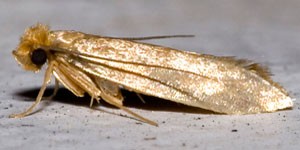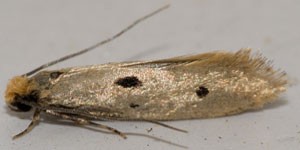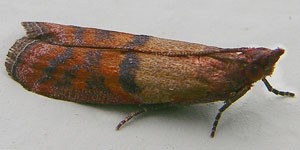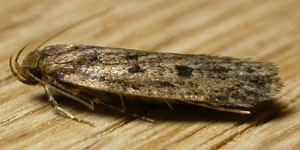Clothes moth traps, flour moth traps and moth bags is recommended for moth prevention and control:
Facts about moths
Moths are a group of insects closely related to butterflies. Although there are more than 160,000 different species of moths in the world, only a very small proportion of these thrive in our homes and are considered pests.
In this theme, you can read about moth infestation control and prevention and learn how to identify the individual moth species. You will find an overview of all our articles about moths here.
What moths are you infested with?
If you are infested with moths - and have found an adult moth - you can try to identify the species using the images below. Click on the image to read more about each species.
Overview of turbine characteristics
| Moth species | Image | Length in cm | Wingspan in cm | Occurrence | Food | Characteristics | Combat | Prevention |
| Clothes moth | 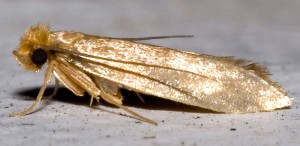 |
0,5 – 0,9 | 0,9 – 1,6 | Frequent | Organic textiles* and possibly also synthetics or plant textiles | Shy - tendency to run rather than fly | Textile cleaning | Proper storage of textiles |
| Fur moth | 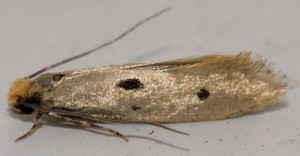 |
0,5 – 0,7 | 1,2- 1,7 | Frequent | Organic textiles* and dry food** | Shy - tendency to run rather than fly | Cleaning textiles + their storage locations | Habitat cleaning + proper storage of textiles and food |
| Frog moth | 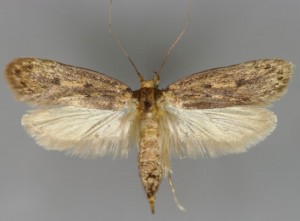 |
0,8 – 1,5 | 1,6 – 2,6 | Common | Organic textiles*, plant materials and certain animal materials | Attracted to light | Cleaning of habitats + cleaning of textiles + possible discarding of food | Reducing damp areas in the home |
| Two-colored seed moth | 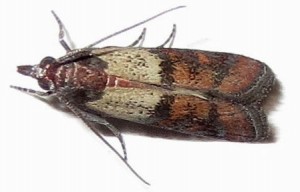 |
0,8 – 1,0 | 1,6 – 2,0 | Common | Dry food** and plant materials | Attracted to light | Habitat cleaning + food discarding | Habitat cleaning + proper food storage |
*Organic textiles are all textiles derived from animals such as wool, fur, feathers, hair, down, silk, leather, etc. However, be aware that plastics and plant materials (such as cotton) can also be attacked if they are unclean or mixed with organic materials, for example.
Please note that we have only included the 4 most common moth species above. You can find a more complete overview with 12 different moth species here.
What are moths?
Moths belong to the moths (also called the moths), which is a suborder of butterflies. There are more than 160,000 different species of moths in the world.
The main differences between butterflies and moths are:
- TaxonomyButterfly is a monophyletic (taxonomic) group, which moths are not. This means that all butterflies are descendants of the same ancestral form, which is not the case with moths, which are descendants of several families of moths.
- AnatomyAlthough there are no clearly defined differences between butterflies and moths, there is one rule of thumb that almost always holds true: butterflies have thin antennae with small spheres at the ends; moths lack these spheres.
Which moths are pests?
As mentioned, there are over 160,000 different species of moths in the world. However, only a very small proportion of these moths thrive in our homes and are considered actual pests.
In Denmark, there are around 15 species, of which only 4 are common. These moths can be divided into two groups:
- Moths that infest textiles
- Moths that infest food
However, this division is by no means all-inclusive, as some moth species infest both textiles and food. In addition, for example, seed moths and sticky moths can also infest plant materials and some animal materials.
Commercial and environmental damage
Some moth species pose significantly greater problems in commercial and environmental settings than in private homes.
In Denmark, this includes flour moths - whose larvae thrive in flour - which can damage production in mills, bakeries, food warehouses and other places where large quantities of flour and grain products are stored.
Abroad (and to a limited extent also in Denmark), there are several different moth species that attack crops, forests, plantations, etc.
The caterpillars are the pests
Most adult moths don't eat anything - they usually don't even have mouthparts. The adult moths that do feed usually consume nectar.
The real pests, however, are the moth larvae, which eat the materials they can digest. The larvae of most moth species feed on a limited group of food items, such as clothes moths, which feed on organic textiles, or bicolored seed moths, which feed on dry foods. However, some moths can feed on food items in several categories, and some species are even (almost) omnivorous.
The extent of the damage
The extent of the larvae's damage naturally depends on the number of larvae and their species.
For example, if you have just one two-colored seed moth caterpillar in your home in a bag of cereal, you can simply discard the bag. If, on the other hand, you see moths flying around the kitchen and find larvae and pupae behind the kitchen cupboard, you need to take a tougher approach.
When it comes to clothes moths, there are also different scenarios; if you find one discarded shirt with a few holes in it, the problem is usually limited and can be solved by thorough cleaning and proper storage of clothes/textiles. If, on the other hand, you find several pieces of clothing with holes in them, you need to take a tougher approach.
Read more about moth control here.
Clothes moth traps, flour moth traps and moth bags is recommended for moth prevention and control:

